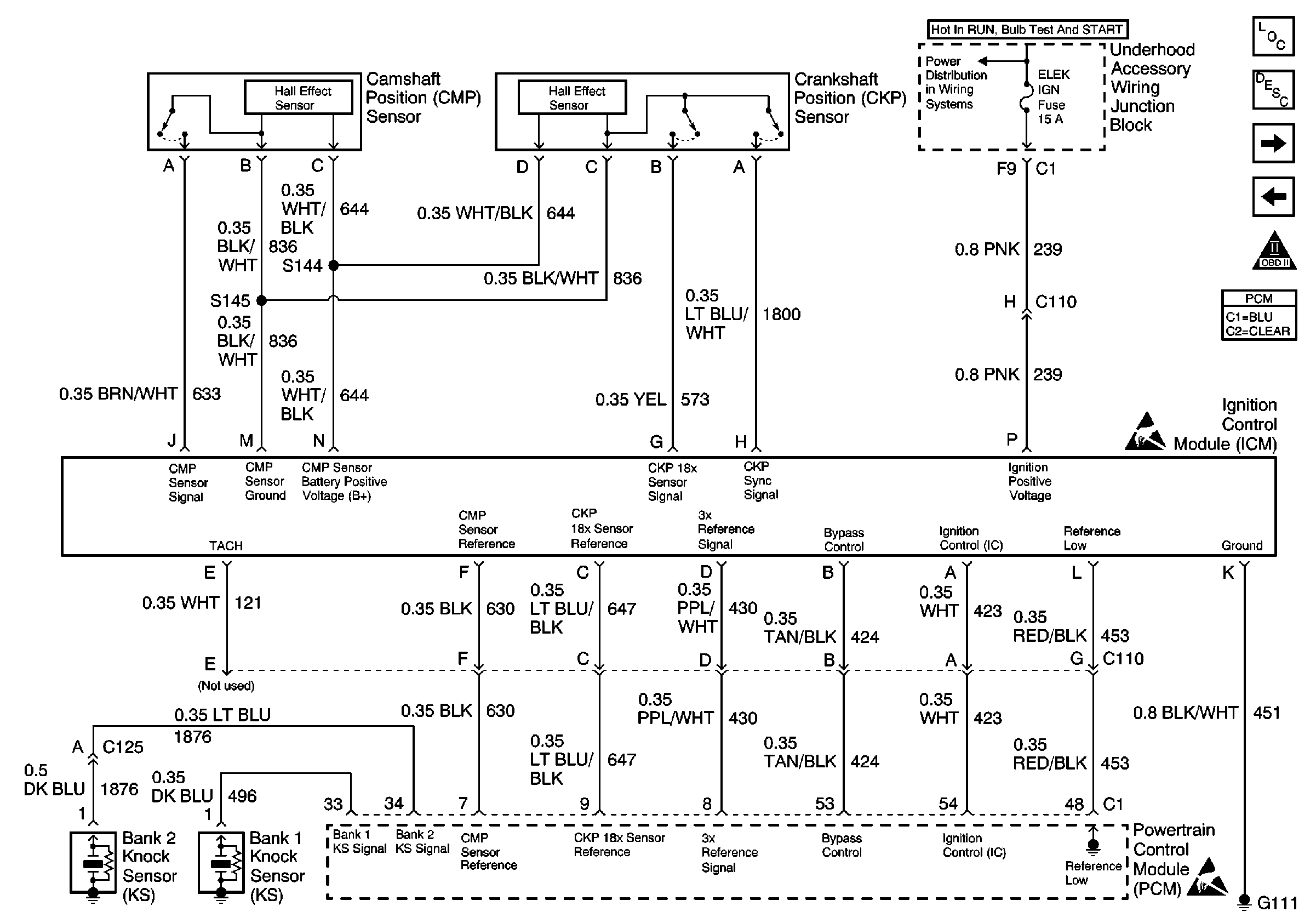Refer to Engine Controls Schematics
CKP, CMP, ICM, Bank 1 KS and Bank 2 KS

Circuit Description
The powertrain control module (PCM) requires ignition control module (ICM) signals for fuel control and for spark advance calculations. At the start of engine crank, the ICM controls the spark advance, or bypass mode. When the PCM recognizes the second 3X reference pulse, the PCM applies 5 volts to the bypass circuit, commanding the ICM to switch spark advance to PCM control, or IC mode. If the PCM detects a short to voltage in the bypass circuit, the engine will start and may run in bypass mode timing. DTC P1362 will set.
Conditions for Running the DTC
The engine is running.
Conditions for Setting the DTC
The PCM detects a short to voltage in the bypass circuit.
Action Taken When the DTC Sets
| • | The PCM will illuminate the malfunction indicator lamp (MIL) during the second consecutive trip in which the diagnostic test has been run and failed. |
| • | The PCM will store conditions which were present when the DTC set as Freeze Frame/Failure Records data. |
Conditions for Clearing the MIL/DTC
| • | The PCM will turn OFF the malfunction indicator lamp (MIL) during the third consecutive trip in which the diagnostic has run and passed. |
| • | The history DTC will clear after 40 consecutive warm-up cycles have occurred without a malfunction. |
| • | The DTC can be cleared by using a scan tool. |
Diagnostic Aids
Inspect for the following conditions:
| • | A poor connection at the PCM--Inspect harness connectors for the following conditions: |
| - | Backed-out terminals |
| - | Improper mating |
| - | Broken locks |
| - | Improperly-formed terminals |
| - | Damaged terminals |
| - | Poor terminal-to-wire connections |
| • | A damaged harness--Inspect the wiring harness for damage. If the harness appears OK, disconnect the ICM, and turn ON the ignition. Observe a DMM that is connected between the IC circuit and B+ while you move the connectors and the wiring harnesses that are related to the ICM. A change in voltage will indicate the location of the malfunction. |
Test Description
The numbers below refer to the step numbers on the Diagnostic Table:
Step | Action | Value(s) | Yes | No |
|---|---|---|---|---|
1 | Did you perform the Powertrain On-Board Diagnostic (OBD) System Check? | -- | ||
2 | Is DTC P1361 also set? | -- | ||
3 |
Is the test lamp ON? | -- | ||
4 |
Is the test lamp ON? | -- | ||
5 | Locate and repair the short to voltage in the bypass circuit. Refer to Wiring Repairs in Wiring Systems. Is the action complete? | -- | -- | |
6 |
Is the test lamp ON? | -- | ||
7 | Locate and repair the short to ground in the IC circuit. Refer to Wiring Repairs in Wiring Systems. Is the action complete? | -- | -- | |
8 |
Is the test lamp ON? | -- | ||
9 | Locate and repair the short to ground in the bypass circuit. Refer to Wiring Repairs in Wiring Systems. Is the action complete? | -- | -- | |
10 |
Did you find a problem? | -- | ||
11 |
Does the voltage toggle between the specified ranges? | 20mV to 40mV 150mV to 250mV | ||
12 | Replace the ignition control module. Refer to Ignition Control Module Replacement . Is the action complete? | -- | -- | |
|
Important:: Replacement PCM must be reprogrammed. Refer to Powertrain Control Module Replacement/Programming . Replace the PCM. Is the action complete? | -- | -- | ||
14 |
Does the scan tool indicate that DTC P1362 failed this ignition? | -- | System OK |
